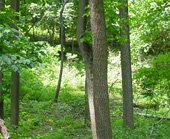|
Since 1999, the Center has focused efforts and resources on creating a preserve that supports the highest level of plant and animal diversity native to southeastern Pennsylvania. Academic study is integrated with recreation and enjoyment to establish a basis for meaningful programs and to help instill a sense of discovery in those who visit our grounds. Until the mid-1960's, the majority of the land that is now part of the Center and surrounding area was farmed. If you look at the Center's woodlands, you will see that the trees are all relatively young. The past agricultural use of the land has strongly influenced the makeup of our current woodlands. Continued disturbance of the soil eliminated much of the seed source for native, successional meadows, edges and woods. This disturbance has allowed invasive, non-native vegetation to thrive as this old farmland reverts to forest. Some non-native species of plants and animals, such as Queen Anne's Lace and honeybees, have been introduced into our ecosystem and coexist with the native species without disrupting the balance. Other non-native species, called "invasives", disrupt the natural process by displacing native plants and creating monocultures. On the Center's grounds, the native understory layer of vegetation has been largely replaced by several non-native, invasive plant species. The "Top Least Wanted" invasives at the Center are: Japanese Stilt Grass (Microstegium vimineum), Oriental Bittersweet (Celastrus orbiculatus), Garlic Mustard (Alliaria petiolata), and Asian Earthworms (Amynthas spp.). |
 |